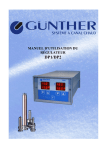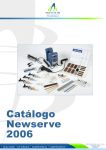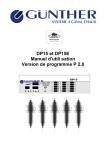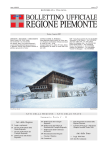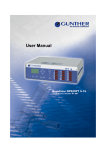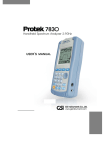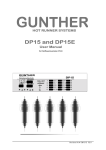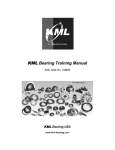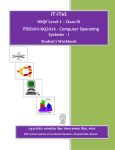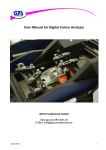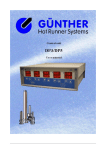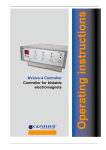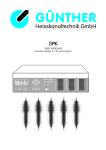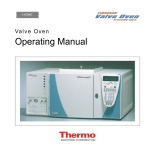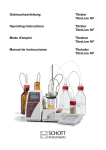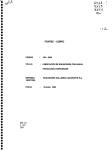Download PDF - Günther Heisskanaltechnik
Transcript
User Manual Hot Runner System DPT20 Table of Contents: Page 1 General ____________________________________________________________________ 1 2 Display and Operating Controls________________________________________________ 3 2.1 2.2 3 CONTROL PANEL _________________________________________________________ 3 PARALLEL DISPLAY _______________________________________________________ 4 Operating Instructions _______________________________________________________ 5 3.1 3.2 3.3 3.4 TURNING ON _____________________________________________________________ 5 MULTI-CHANNEL MODE ___________________________________________________ 5 SINGLE-CHANNEL MODE ___________________________________________________ 6 OPERATING MODE ________________________________________________________ 7 3.4.1 Changing Set Values ____________________________________________________________________ 7 3.4.2 Switching Zones On and Off ______________________________________________________________ 8 3.4.3 Changing the Operating Mode „Percentage/Slave/Temperature“ ________________________________ 9 3.4.4 Temperature Lowering / Boost ___________________________________________________________ 10 3.5 MENU MODE ____________________________________________________________ 11 3.5.1 Set all Channels _______________________________________________________________________ 13 3.5.2 Temperature Program _________________________________________________________________ 13 3.5.3 Temperature Lowering / Boost ___________________________________________________________ 14 3.5.4 Power Monitor ________________________________________________________________________ 14 3.5.5 Diagnosis ____________________________________________________________________________ 14 3.5.6 Configuration_________________________________________________________________________ 15 3.5.7 Language ____________________________________________________________________________ 15 3.5.8 Start-up Ramp ________________________________________________________________________ 15 3.5.9 Temperature Window __________________________________________________________________ 16 3.5.10 Molding Machine (Serial Interface) ______________________________________________________ 16 3.5.11 Turn on Time ________________________________________________________________________ 16 3.5.12 Set Tool Timer _______________________________________________________________________ 16 3.5.13 Error History ________________________________________________________________________ 17 3.5.14 Service _____________________________________________________________________________ 17 3.6 CONFIGURATION MENU ___________________________________________________ 18 3.6.1 Softstart _____________________________________________________________________________ 18 3.6.2 Load Defaults _________________________________________________________________________ 19 3.6.3 PID - Parameter_______________________________________________________________________ 20 3.6.4 Th.couple Assignment __________________________________________________________________ 20 3.6.5 Thermocouple Type____________________________________________________________________ 20 3.6.6 Switching °C / F _______________________________________________________________________ 21 3.6.7 User Password ________________________________________________________________________ 21 3.6.8 Parameter____________________________________________________________________________ 21 11/05 DPT20 User Manual Hot Runner Systems DPT20 4 Other Functions ____________________________________________________________ 27 4.1 4.2 4.3 4.4 4.5 4.6 5 Serial Interface _____________________________________________________________ 32 5.1 5.2 6 READY TO START MOLDING OPERATION _____________________________________ 27 AUTOMATIC SLAVE MODE _________________________________________________ 27 TEMPERATURE LOWERING / -BOOSTING WITH TEMPERATURE PROGRAM ___________ 27 STANDSTILL – MONITORING _______________________________________________ 28 FRICTION-RECOGNITION AND -MONITORING __________________________________ 28 FAULT REPORT __________________________________________________________ 29 GENERAL INFORMATION __________________________________________________ 32 TROUBLE SHOOTING ______________________________________________________ 33 Installation, Start-Up and Maintenance ________________________________________ 34 6.1 INSTALLATION ___________________________________________________________ 34 6.1.1 Location _____________________________________________________________________________ 34 6.1.2 Electrical Connections__________________________________________________________________ 34 6.1.3 Additional Interface____________________________________________________________________ 35 6.2 START-UP ______________________________________________________________ 39 6.2.1 Initial Start-Up________________________________________________________________________ 39 6.2.2 Additional Information _________________________________________________________________ 39 6.3 MAINTENANCE __________________________________________________________ 39 6.3.1 EPROM Update_______________________________________________________________________ 39 7 Appendix __________________________________________________________________ 41 7.1 7.2 7.3 7.4 7.5 7.6 7.7 7.8 7.9 APPENDIX A – CONNECTIONS TO THE DPT20__________________________________ 41 APPENDIX B - FUSES ______________________________________________________ 42 APPENDIX C – STAR-/DELTA OPERATION _____________________________________ 44 APPENDIX D – TECHNICAL DATA ___________________________________________ 46 APPENDIX E - SERVICE FORM ______________________________________________ 49 APPENDIX F – SCHEMATIC _________________________________________________ 51 APPENDIX G – POSITION SCHEMATIC ________________________________________ 55 APPENDIX H - ADDRESSES _________________________________________________ 57 APPENDIX I – EG DECLARATION OF CONFORMITY ____________________________ 61 11/05 DPT20 User Manual Hot Runner System DPT20 11/05 DPT20 User Manual Hot Runner System DPT20 Warranty Conditions: 1. Installation and implementation must be carried out by an electrician! 2. Please refer to chapter 6 – Installation, Start-up and Maintenance of the user manual prior to the installation of the device! 3. Before connecting the device to the main’s power supply, check the main’s voltage and the type of net (star or delta)! 1 General The hot runner system DPT20 has been built and tested according to DIN 57411 part 1 and VDE 0411 part 1 (Germany). It has left the factory in perfect condition. In order to keep your product totally operational and to guarantee safe operation, please read this instruction manual carefully and follow all hints. Before switching on, it is important to check if the local voltage is identical to that allowed by the unit. The plug may only be plugged into an earthed socket. Any disconnection of the earth cable (e.g. an extension of the cable without earth connected) can cause hazardous conditions to the unit. Hint: Disconnect mains before opening the unit. Refer to a qualified technician for servicing. ! ! ! ATTENTION ! ! ! This is a user manual for DPT20 units. User of the DPT20 have to consider that these devices are only to use with 230V-nozzles. If the device is used to temperate low voltage-nozzles (5V or 24V) anyway, this may cause defects and will lead to the loss of guarantee. Never connect a DPT20 to low voltage-nozzles but only to 230V-nozzles ! The DPT20 unit is an optimized hot runner control unit, it is very efficient and reduces costs. Advantages for the user: • PID controller with variable parameters, careful heating of 230V-zones. • An automatic slave mode is able to switch zones with faulty thermocouples into slave mode automatically. • A manual slave mode can be activated for each zone • Control operation is possible at all times, even in the event of thermocouple failure. • Because of the module construction, system upgrades are possible. The DPT20 is reliable and safe, due to continuous checking and monitoring functions. Advantages for the user: • Continuous self-monitoring function. • Identifies thermocouple failures, heat circuit disconnections and short circuits. • Turns off the power supply in case of a malfunction. • Parameters and programs are saved in an EEPROM and are therefore not lost in case of a power supply failure. 11/05 DPT20 1 User Manual Hot Runner System DPT20 The DPT20 is designed for easy use; this makes installation and tool change simple. Advantages for the user: • The DPT is especially designed for simple and easy operation. • The multi-function keypad has an easy to use layout and because of its dust and water proof key pad, it withstands tough environments. • The simple operator entry level prevents wrong operation. • All zones and the set and current values for each zone are displayed simultaneously. • The control parameters are adjustable according to the application. • The implemented diagnosis function tests the complete system, including tools, nozzles, manifolds and the hot runner system for malfunction and is able to correct possible miswirings independently. • Circuits, connected incorrectly, are located before the start of an operation. • Low installation costs because of combined thermal and power connections. The DPT20 has numerous special functions for optimal system utilization. Advantages for the user: • Power output surveillance is possible during an operation. • Decreasing and increasing temperature for all control points by simply pressing a key. • Reading of the effective current at low voltage. • Several set value programs facilitate possible material or tool changes. • If desired, a serial interface is available as connection to an injection molding machine. • Adjustable timer for heating the tool befor start of work. 2 11/05 DPT20 User Manual Hot Runner System DPT20 2 Display and Operating Controls The display and operating controls of the DPT20 separated into the operation control panel and the parallel display. Great emphasis has been placed upon ease of use and a good layout. 2.1 Control Panel A 0 Zone 1 2 3 4 5 Exist 200° 150° 0° 100° 100° Set 200° 200° 300° 100° 100° H Power 0% 50% 100% 0% 0% 17:45:00 I J ENTER B C D G E F Fig. 2-1 Control panel DPT20 Function Keys A Switch B Key ON A Key „ “ B Key „ “ C Key „MENU“ D Key „ENTER“ ⇒ ⇒ ⇒ ⇒ ⇒ ⇒ E – H Keys „3“, „5“, „4“, „6“ ⇒ front side power switch tool heater ON/OFF lowering temperature in all zones boosting temperature in all zones show menu ´ENTER´ key to confirm inputs, to quit program levels changing & adjusting set values and parameters, cancel function Hint: For further details concerning keys and their functions see chapter 3.3 Operation. 11/05 DPT20 3 User Manual Hot Runner System DPT20 2.2 Parallel Display The parallel display consists of 20 three-digit seven-segment displays to exhibit set temperature, present temperature, temperature difference or current adjustable variables in ´%´. Three additional LEDs are located beside each indicator to display the status of the zone. If a zone is turned off, “---“ appears in the accompanying display. The percent control variable is displayed to zones which work in percentage control mode. In addition, the temperature state is one by one displayed for each zone. If the green indicator shines behind the corresponding value, this zone has reached the programmed temperature window (ready for molding operation). If the temperature exceeds the temperature window or lags behind it, the red indicators will show. channel select key for every zone Fig. 2-2 Parallel Display DPT20 Between the operating control and the parallel display the “5“ key and 4 LEDs are placed. The key is used to display set value, current value, temperature difference or the display of current in “%“. The LEDs above the key show the selected display type. 4 11/05 DPT20 User Manual Hot Runner System DPT20 3 Operating Instructions 3.1 Turning On After the unit has been switched on, the GÜNTHER logo, the program revision number and the serial number appear on the display. Then the unit automatically performs a system check including the heating circuits and tests whether a 230V-load is connected. The display will show the table “load recognition”, which is divided into the tested channel’s number and its potential power. At the same time the respective field of the parallel display shows “---“ (Test) and then the detected voltage of the load. If a load turns off due to a fault or if it is not connected, the parallel display will show “---“. During initial start-up (and/or after resetting the controller to its factory settings) the unit starts an question after switch on, in that the language for the menu can be set by keys „5“ and „6“. If this question is not operated within five seconds, English will be adjusted as current language automatically. 3.2 Multi-Channel Mode After the adjusting of the loads, the controller is in multi-channel mode. In this mode always five zones are displayed for a short time interval. Zone Exist Set Power 1 200° 200° 0% 2 150° 200° 50% 3 0° 300° 100% 4 100° 100° 0% 5 100° 100° 0% Fig. 3-1 Multi-Channel Mode The set value and the current value in degrees centigrade or degrees fahrenheit are displayed in this mode. The control value is displayed in percent (%) for 230V-nozzles Hint: At the appearance of any failure the multi-channel mode will be interrupted and the failure will be visualized on the display. If several errors occur, the zone, whose error was recognized first, will be displayed. This is also valid if the display is switched from menu mode to multichannel mode after the appearance of any failure. 11/05 DPT20 5 User Manual Hot Runner System DPT20 3.3 Single-Channel Mode To change from multi-channel to single-channel mode, mark a zone with keys „5“ or „6“. By pressing key „4“ or „Enter“ this zone is entered in single-channel mode. In this mode all data (set value, actual value, load character, current or power consumption) of the displayed zone is shown. ZONE 1 1,03 kW Act. Set 200 °C 200 °C 0.0A 30% Fig. 3-2 Single-Channel Mode In single-channel mode the zone number is marked at first. By pressing key „3“ the display mode returns to multi-channel mode. After two seconds the mark fades out and then it is possible to turn the display mode to the scan mode by pressing key „3“. The following sign indicates the scan mode. In this mode the zones with set and current values will be shown on the display one by one. Zones which are switched off will be skipped. The scan mode can be cancelled by pressing any key and restarted by pressing key „3“ after two seconds when the marking of the zone number faded out again. Hint: If a fault occurs, the scan mode will be terminated and the channel as well as its fault will be displayed. If several faults occur simultaneously, the first identified one will be shown. 6 11/05 DPT20 User Manual Hot Runner System DPT20 3.4 Operating Mode 3.4.1 Changing Set Values For changing the set value of a zone it has to be switched into single channel mode (see picture A). Then the set value can be marked by pressing key „4“ and the desired set value can be adjusted by pressing keys „5“ and „6“. The key function is dynamic, i.e. the longer the key is pressed, the quicker the set point value changes. CH 1 1,03 kW Act. Set ON 200 °C 200 °C Temp. Picture A Ch 1 2 3 4 5 Exist 200° 150° 0° 100° 100° Set 200° 200° 300° 100° 100° Power 0% 50% 100% 0% 0% 17:45:00 ZONE 1 1,03 kW Ist Soll ON 200 °C 200 °C Temp. Picture B °C/F↑ ZONE 1 1,03 kW Ist Soll ON 200 °C 250 °C Temp. Picture C Fig. 3-3 Changing a Set Value Indeed the controller operation works independently from the entering of a value. It is therefore not necessary to return to the scan mode. The scan mode makes exact surveillance of critical regulation positions possible. For faster adjusting of all set values to the same value, the command “Set all channels” (see Chapter 3.5.1 Set all channels) may be used. Value limits: The temperatures are adjustable within a range from 0 to 500°C (0 to 932°F). As a default the excess temperature disconnection is set to 500°C. If a less safety shutdown is carried out in the parameter menu, the set value attitude of this value is also limited. The percentage control mode is adjustable from 0% to 100%. 11/05 DPT20 7 User Manual Hot Runner System DPT20 3.4.2 Switching Zones On and Off If a zone is unused, it is possible to switch it off. CH 1 230V Act. °C Set 200 °C OFF Temp. Picture A Ch 1 2 3 4 5 Exist 200° 150° 0° 100° 100° Set 200° 200° 300° 100° 100° Power 0% 50% 100% 0% 0% 17:45:00 CH Act. 1 Set 230V ON 40 °C 200 °C Temp. Picture B °C/F↓ CH 1 230V Act. Set ON °C/F↑ 200 °C 200 °C 4A Picture C Fig. 3-4 Switching Zones On and Off In single-channel mode move the mark to the ON/OFF-button by pressing key „4“. Now the setting can be changed by pressing key „5“ or „6“. Hint: Zones, which are switched off, will only be displayed in multi-channel mode and are not checked on faults anymore. 8 11/05 DPT20 User Manual Hot Runner System DPT20 3.4.3 Changing the Operating Mode „Percentage/Slave/Temperature“ In the case that a thermocouple fails to function, or for any other reason, it is possible to continue the control operation manually in slave mode or in percentage control mode. For that purpose the menu item “Power”, “Temp.” or “Slaving” are marked with key „4“ and can then be chosen by pressing key „5“ or „6“. CH Is 1 Set 230V ON 200 °C 200 °C Temp. Picture A Ch 1 2 3 4 5 Exist 200° 150° 0° 100° 100° Set 200° 200° 300° 100° 100° Power 0% 50% 100% 0% 0% 17:45:00 CH Is 1 Set 230V ON 200 °C 200 °C Temp. Picture B °C/F↓ CH 1 230V °C/F↑ Percentage 5 ON % Power Picture C Fig. 3-5 Changing the Operating Mode Temperature control mode In this mode temperature control is accomplished by means of a fuzzy PID controller, which evaluates the signal of the thermocouples and adapts the corresponding power at the exit. Slave mode This mode of operation can be used for zones, in which an error or defect at the thermocouple has occured. Here the faulty zone is attached to a freely selectable zone and operated with the same power output as the leading zone. Please note that the leading zone and the attached zone exhibit a similar behaviour. Percentage control mode This mode allows to adjust a fixed power output between 0 and 100% for the selected zone. 11/05 DPT20 9 User Manual Hot Runner System DPT20 3.4.4 Temperature Lowering / Boost Temperature Lowering If production stops for a longer period of time, it is advisable to lower the set temperatures without turning the unit off. By pressing key „ “ lowering temperature is activated. In multi-channel mode the display shows „T- Lowering“ + the adjusted lowering value at the left corner, in single-channel mode the following sign is displayed. An external activation for lowering temperature is possible by connecting a closing contact at the rear side of the DPT20. It is possible to connect a potential free contact to the unit with a cable which is available from GÜNTHER HOT RUNNER SYSTEMS (especially to relay output of injection molding machines). Temperature Boost For starting up the tools it is helpful to boost up the temperatures of all zones for a short time. By pressing key „ “ temperature boost is activated. In multi-channel mode the display shows „TBoost“ + the adjusted rising value at the left corner, in single-channel mode the following sign is displayed. After a preadjusted time (120sec.) temperature boosting ends automatically. It can also be ended by further activating of the key. Normally, the manifolds are excluded from temperature boost. However, they can be integrated in the boosting function, if parameter -22- (Menu Configuration Parameter -22- “boost for manifolds”) is set to “1”. Besides, an external activation of the boosting function can be carried out. For that purpose, the external lowering function has to be deactivated, because both functions are operated via the entrance (Abs.) at the DPT20’s rear. For deactivating the external lowering function and/or for activating the external boosting function, the value for the parameter -25- (Menu Configuration Parameter -25- “ext. input for boost”) has to be set to “1” in parameter menu. Hint: All settings can be carried out via the menu options “Temp. Lowering” and “Temp. Boost”. 10 11/05 DPT20 User Manual Hot Runner System DPT20 3.5 Menu Mode By pressing key „Menu“ the menu mode is activated. The main menu will be shown on the display. Main Menu Fig. 3-6 Main Menu Use keys „5“ and „6“ to select and key „4“ or „ENTER“ to confirm a menu item. If the operator does not make modifications in the main or in another menu, the display mode will be switched off after a time of 10 seconds and the display will show single- or multi-channel mode. If a menu item is confirmed, the value may be changed by pressing keys „5“ and „6“. By pressing key „3“ or „ENTER“ you will return to the menu. If the „ENTER“ key is used, the displayed value will be stored as a new set value. By using key „3“, the value will not be stored (cancel function). The menu structure is on the next page. 11/05 DPT20 11 User Manual Hot Runner System DPT20 Menu structure of the DPT20 Main Menu set all channels temp. program temp. lowering temp. boost power monitor diagnosis configuration softstart load defaults language calibration start-up ramp pid-parameter temperature window set tool timer molding machine th.couple assignment turn on time thermocouple type tool timer switch °C/F error history user password service parameters Fig. 3-7 Menu structure of the DPT20 12 11/05 DPT20 User Manual Hot Runner System DPT20 3.5.1 Set all Channels The menu „Set all channels“ enables the operator to change the set temperature or to turn on or off all zones. Main Menu Set all temp. °C 100 ON/OFF: ON Temp. : - ENTER Picture A °C/F↓ °C/F↑ Fig. 3-8 Set all Channels 3.5.2 Temperature Program A set value program is a preprogrammed series of set values and their corresponding operating methods which a user can change and enter into the system. They can be entered and activated solely by the menu „Temp. Program“. If the tools or the molding compounds have been changed, it is advisable to change the program accordingly. There are four set value programs available. When the control unit is turned on, the last one of the previous used programs will be reactivated automatically. To reset all programs and parameters, select the menu item „Load Defaults“ (see chapter 3.6.2 Load Defaults). Main Menu Temp. Program 1. power 2. power 3. temp. 4. temp. default ON OFF ON OFF 50% 75% 100° 200° Picture A °C/F↓ °C/F↑ Fig. 3-9 Changing Temperature Program 11/05 DPT20 13 User Manual Hot Runner System DPT20 3.5.3 Temperature Lowering / Boost By the two menus „Temp. Lowering“ and „Temp. Boost“ the operator can set a temperature increase or decrease. By using key „ “ the temperature decreases to the value which has been adjusted in the menu „Temp. Lowering“. By using key „ “ the temperature raises to the value which has been set in the menu „Temp. Boost“. 3.5.4 Power Monitor The menu “Power Monitor“ shows the total power consumption and the current separated for each phase at the moment. Power Monitor Main Menu L1 L2 L3 7.1 A 5.6 A 8.2 A Total Power: 1560 W 1232 W 1804 W 4596 W Picture A Fig. 3-10 Power Monitor 3.5.5 Diagnosis Within the menu item “Diagnosis”, a check of zone assignment and wiring can be carried out. For that purpose, all channels are first cooled down after the start of the diagnosis. Afterwards all channels are heated up separately and the reaction of the thermocouples will be established. This way possible miswirings at the thermocouples can be located and repaired, if necessary. During the diagnosis, each zone to be tested, its kind of heater as well as the established reaction of the corresponding thermocouple are displayed in a line. At the end of the line, a short evaluation text is announced (see below). If assignment mistakes (zone thermocouple) are recognized within the diagnosis, the user will be asked, if these mistakes should be repaired automatically at the end of the diagnosis. If the user answers with “Yes”, a logical re-connection of the circuits will be carried out and the hot runner system can be operated without any hardware modification. Otherwise the user has to repair the assignment mistakes by changes within the hardware. If errors occur, which the system cannot debug independently, the faulty zone will be switched off. 14 11/05 DPT20 User Manual Hot Runner System DPT20 Evaluation: Display wire no sig. break no load OK Description Assignment mistake (zone thermocouple) Thermocouple Shortcut Thermocouple interrupted no load / load interrupted no error Debugging Automatic debugging Manual debugging Manual debugging Manual debugging 3.5.6 Configuration By choosing the menu item “Configuration“ the configuration menu will be entered. You need a password to enter this menu. In the configuration menu the operator can change the language, the PID parameter or calibrate the DPT20 etc. For further information refer to Chapter 3.6 Configuration Menu. 3.5.7 Language In the menu item “Language“ you are able to change the language for the display and the menu. The DPT 20 supports the following languages: English German French Portuguese Italian Dutch Danish Polish 3.5.8 Start-up Ramp In hot runner systems you will often find loads with different thermic time constants. If the time constants differ widely, a fast nozzle will reach its set value earlier than the slow manifold. This physically based heat-up delay can generate plastic defects in the nozzle, because it reaches the set value much earlier than the other nozzles. For this reason the starting mechanism ”Start-up Ramp“ is connected. This guarantees a regular warming of the different nozzles related to the set value. The ramp function can be switched on and off in the menu item “Start-up Ramp”. Additionally it is possible to choose a zone for leading the ramp or the adjustment “auto”. Within the adjustment “auto” the DPT20 establishes the slowest zone in a 90-seconds-lasting testing phase independently and determines it as leading zone. Furthermore a lowering value can be adjusted for all zones (except the leading zone). Around this value the set values of all zones are lowered until the leading zone has reached its set value. If the ramp function is switched on and the softstart is ended, it will be activated with each set value leap >50. Then the leading zone is heated to its set value. According to their percentage of the set value the other nozzles are driven up slowly to their set values, so that their heating procedure is braked essentially. 11/05 DPT20 15 User Manual Hot Runner System DPT20 The end of the starting ramp is achieved as soon as the leading zone has reached its temperature window. Just now the individual nozzles will be decoupled from the leading mechanism and heated to their set value. In multi channel mode the starting ramp is indicated by the text “Ramp” and by displaying the leading zone. In single channel mode the following symbol is displayed. 2 The number behind the sign indicates the slowest zone (manifold). 3.5.9 Temperature Window Within this menu item a tolerance for the existing temperature can be specified. This implies that, if the actual temperature of a zone reaches a value which lies within the set value +/- the tolerance, this zone will be declared as ready to start molding. This is shown by flashing of the corresponding zone’s green OK indicator in the parallel display. If all zones are within their tolerance sector around the set value, the DPT20s OK-exit will be set and the tool will be ready for duty. Additionally, the message “ready for molding” is shown on the display. Appropriate to the default values the temperature window’s value is set to +/- 10°C. 3.5.10 Molding Machine (Serial Interface) A transmission protocol for the DPT20’s COM2-interface can be adjusted in the menu item “Molding machine”. The COM2-interface is an optional extension of the control element and can be installed directly when buying the controller or subsequently. Via this interface a communication between controller and molding machine is possible, so that the controller can be operated by the molding machine. At the moment there are transmission protocols available for Arburg-, Engel- and Krauss-Maffei interfaces (see Chapter 5 Serial Interface). 3.5.11 Turn on Time The hours of operation are displayed in the menu item “Turn on Time“. They describe the time in which the DPT20 has been switched on (from its first operation on) and will be displayed in hours and minutes. 3.5.12 Set Tool Timer The tool timer is used for switching on the tool heater at a a particular time, e.g. half an hour befor start of work. Set the switch on time in the menu. Choose between a certain day or every day. To switch the timer off, choose never. 16 11/05 DPT20 User Manual Hot Runner System DPT20 3.5.13 Error History Within this menu item it is possible to see the last occurred and receipted mistakes related to the hours of operation. The meter reading of the hours of operation (from the moment of the occurred error on) is followed by the error report. The occurred fault will be distributed as a shorthand expression. The list contents the 64 last occurred faults. It is possible to leaf through the list with keys „5“ and „6“. The following list shows the meanings of the different error-shorthand expressions. Error shorthand expression Description Hours:Min Hours:Min Hours:Min Hours:Min Hours:Min Hours:Min Hours:Min Hours:Min Hours:Min Contact problems at thermo plug Contact problems at load plug Calibration Thermoelement error at zone xx: Thermoelement Failure Thermoelement error at zone xx: Thermoelement Shortcut Thermoelement error at zone xx: Overtemperature Zone xx: Load Interrupted Zone xx: Load Shortcut Zone xx: Deviation from rule Thermo plug Load plug calibration Zxx Th break Zxx Th short Zxx Th over Zxx Load break Zxx Load short Zxx Th over 3.5.14 Service This menu item is used by the manufacturer of the DPT20 for several settings. It has its own password. The user must not and needs not make any changes to this item. 11/05 DPT20 17 User Manual Hot Runner System DPT20 3.6 Configuration Menu By scrolling through the main menu, the configuration menu can be entered. A password is needed to enter this menu. In the configuration menu the operator can change the PID parameter or calibrate the DPT20 etc. The password for the configuration menu is: 0099 The entered password is only valid for 15 minutes or up to the moment when the DPT20 is turned off. For further changes to the configuration you need to enter it again. Configuration Fig. 3-11 Configuration 3.6.1 Softstart When 230V-nozzles are connected to the system, it is necessary to employ the softstart start-up procedure to dry out the moisture that has collected in the cold heating elements. The softstart is divided into two time controlled phases. During the first phase the value of the menu softstart does increase from 0 to 50%. (The ramp time should be selected in such a manner that the DPT20 reaches the temperature of 105°C at the end of the ramp.) If the temperature at the end of the ramp is less than 105°C, the DPT20 will raise it to 105°C independently. After the DPT20 has reached the 105°C, the second time controlled phase of the softstart begins. Within this phase the temperature of the zones is hold to 105°C as long as the hold time is set in the menu item, so that the nozzles dry out adequately with a low thermic load. Ramp time and hold time add up to the whole time, which can be adjusted in the menu in two-minute steps. This start-up operation begins automatically, if the softstart has been activated in the menu and if the actual temperature of a 230V-nozzle remains below 80°C and the set value is over 100°C. In single channel mode the softstart is indicated by the following signs. ramp time hold time In multi channel mode it is indicated by the text „softstart“ and the time left. After the whole time the unit will be switched to normal operating mode. The temperature lowering function is taken into consideration during softstarts, so that the DPT20 unit can begin to operate immediately with an instant temperature lowering. 18 11/05 DPT20 User Manual Hot Runner System DPT20 3.6.2 Load Defaults By selecting the menu item ”Load Defaults“ and affirming the questions with yes twice, the DPT20 loads up the parameters and values to the factory settings. Attention! All individually entered settings of the DPT20 (values and parameters) will be deleted. The following table shows the default settings: Set all Channels: (all set temperatures) 150°C ON Temperature Programs: 1. power 2. temp. 3. temp. 4. temp. OFF ON ON ON Softstart: ON over all time: hold time: ramp time: 10min 5min 5min PID-Parameter: (for all zones) 25% 20°C 150°C 200°C nozzle (<600W): P-Value: 100 I- Value: 9 D-Value: 0 manifold (>600W): P-Value: 100 I-Value: 4 D-Value: 0 Temperature Unit: °C Temperature Window: +/- 10°C Lowering Value: 50°C Rising Value: 20°C Language: English Interface: DP-Intern 11/05 DPT20 19 User Manual Hot Runner System DPT20 3.6.3 PID - Parameter The operator can change the PID parameter using the menu item “Pid-Parameter“. So the operator is able to match the parameters to the controlled system. It is possible to match the several parameters independently. 3.6.4 Th.couple Assignment Within this menu item the user is able to see and change the assignment of the thermocouples to the zones. This way it is possible to combine zones and thermocouples in any order. To avoid open regulating circuits, each thermocouple can only be assigned to one zone. With the cursor-keys the thermocouple assignment can be adjusted. With keys „5“ and „6“ a zone can be selected. To change the thermocouple of this chosen zone, the number of the corresponding thermocouple has to be selected with key „4“. By pressing key „3“ the selection of the thermocouple’s number will be abolished and the line for the zone will be selected again. Now another zone, of which the thermocouple assignment has to be changed, can be chosen. Then the entered values can be accepted by pressing key “ENTER”. With keys “MENU” or „3“ the menu item can be left again without accepting the changed setting. 3.6.5 Thermocouple Type Besides the type L thermocouples, the hot runner system also supports type J and K thermocouples. In the menu item “Thermocouple Type “ the thermocouple’s type can be adjusted for each zone (as well as for all zones). To adjust the thermocouple’s type, one zone or even all zones are selected with keys „3“ or „4“. Then the type can be set with keys „5“ or „6“. When confirming the changes with key “ENTER”, the new setting will be accepted. With key “MENU” or after repeated pressing of key „3“, the menu item can be left without accepting the new adjustment. If type K thermocouples have been adjusted, an infobox is displayed when switching the controller on next. This infobox shows a list of all zones with type K thermocouples. Furthermore the type K thermocouples are displayed at the left corner in single channel mode. In this mode the load’s indication switches with the thermo-type’s indication. Type J and L thermocouples are not announced separately, because they show a similar behaviour. When loading the default settings, all thermocouples will be resetted to type L. 20 11/05 DPT20 User Manual Hot Runner System DPT20 3.6.6 Switching °C / F By choosing the menu item “Switch °C/F“ it is possible to change between degrees centigrade and degrees fahrenheit. Configuration Switch °C/F Temperature in: Celsius Fahrenheit - ENTER - Picture A Fig. 3-12 Switching °C/°F 3.6.7 User Password In the menu item ”User Password“ the creator of the system is able to adjust a password that must then be entered by the user to carry out changes to the set points or to the operating mode. Standardly this function is deactivated, i.e. the code is set on zero. 3.6.8 Parameter The menu item „Parameter“ is only to be used by authorized personnel. Parameter changes can influence the function of the controller. Please take consultation with the GÜNTHER Hot Runner Systems Company, if changes at the system’s parameters seem to be necessary. This applies especially to the parameters marked grey in the following short description. Short description of the adjustable parameters: (Menu Configuration Parameter) -1- max. temperature °C Maximum permitted temperature. If a zone exceeds the adjusted temperature-value, the controller will switch off the power output and display the error “Zone xx Thermocouple: Overtemperature”. default: 500 min: 0 max: 500 11/05 DPT20 21 User Manual Hot Runner System DPT20 -2- controller address Specifies the controller’s device address. default: 3 min: 0 max: 20 -3- diff. temp. rampe °C Shows the temperature difference, which has to be identified on at least one manual or automatic established manifold, for activating the ramp-function. default: 20 min: 0 max: 500 -4- lowering percent in % Lowering value for percentage control mode. default: 20 min: 0 max: 100 -5- boost percent in % Boosting value for percentage control mode. default: 10 min: 0 max: 50 -6- % load difference Maximum permitted deviation of the zones’s heating capacity among one another. (This parameter is not in use at the moment.) default: 70 min: 0 max: 100 -7- temp. windows 2 °C Tolerance window for compensating overheating. If the set temperature has been exceeded by more than the adjusted value, the zone is switched off and the error message “Zone xx Load: Regulating deviation” is displayed. default: 50 min: 0 max: 500 -8- max 5V current in A Maximum current, on which the 5V-loads will be adjusted. default: 125 min: 0 max: 150 -9- cooling ramp at °C The ramp for regulated cooling of a zone begins with the set temperature plus the adjusted value. default: 40 min: 0 max: 100 -10- heating ramp at °C The ramp for regulated heating of a zone begins with the set temperature minus the adjustable value. default: 30 min: 0 max: 100 22 11/05 DPT20 User Manual Hot Runner System DPT20 -11- no load timeout sec. Adjustable time for identifying a load interruption. To release a load-interruption-error, a zone with a power output of > 98% has to be operated during the indicated time, without the zone’s set temperature having risen. For manifolds (loads > 600W) the double testing time is applied. default: 60 min: 0 max: 500 -12- ext. controller addr. Address of a device connected externally (e.g. Arburg molding machine). default: 1 min: 0 max: 20 -13- passwort customer Password allowing the user to carry out changes in the configuration menu. default: 99 min: 0 max: 9999 -14- passwort Additional password for locking single functions concerning set value changes. If „0“ is set here, this password-function is deactivated. For the first activation of this function the controller has to be restarted. default: 0 min: 0 max: 9999 -15- display averaging The set value is displayed as median value, which has been determined from the single set temperatures of the several zones. Within this parameter the user is able to adjust how many set temperatures should be considered for establishing the median value being displayed. default: 10 min: 0 max: 20 -16- test 5V after 230V Switching on / off the plausibility-function. The plausibilty-test checks, if low voltage-loads follow 230V-loads. default: 1 min: 0 max: 1 -17- diag. max. temp. °C Temperature difference, to which a zone has to be heated up during the diagnosis. Only if this difference temperature has been reached during the diagnosis (within the adjusted time), the zone is accepted as OK. default: 30 min: 0 max: 200 -18- diag. heating time sec Time, in which the zone has to reach the difference temperature during the diagnosis. default: 240 min: 0 max: 1200 -19- diag. output in % Power output, with which the zone is operated during the diagnosis. default: 40 min: 0 max: 100 11/05 DPT20 23 User Manual Hot Runner System DPT20 -20- diag. cooling time sec Time, used for cooling down the tools, before the actual diagnosis starts. To avoid incorrect measurements during the diagnosis (by unintentional heating of neighbouring zones) and to guarantee a regular cooling procedure, the adjusted time is bided once again half after the checking of the single zones. default: 60 min: 0 max: 1200 -21- low time visible (from Softwarevers. 1.33: -21- molding machine check) If this parameter is set to „1“, a monitoring of the molding machine will be realized via the "external lowering entrance". In this case, the actual “lowering function” is however annuled. Realization of monitoring: If the molding machine is active and in perfect condition, it has to keep the contact for the external lowering closed. It opens this contact, if an error at the molding machine occurs. Then the controller activates the lowering function after the time which has been adjusted in the menu item “Temp. lowering (ext.)”. This kind of lowering provides that the controller is in ready-for-molding mode. Now the lowering key serves for putting back the external lowering. Within this setting the actual lowering-function can not be used any more. Standstill-Monitoring: default: 0 min: 0 max: 1 -22- boost for manifolds If this parameter is set to „1“, the temperatures of the manifolds (load > 600W) will be risen, too, when switching on the boosting function. default: 0 min: 0 max: 1 -23- program -3- for lower If this function is activated („1“), temperature program 3 will be loaded and the controller will work with the values set there (when lowering is carried out). default: 0 min: 0 max: 1 -24- program -4- for boost If this function is activated („1“), temperature program 4 will be loaded and the controller will work with the values set there (when boosting is carried out). default: 0 min: 0 max: 1 -25- ext. input for boost By activating this function the „external lowering entrance“ is converted into an „external boosting entrance“. If then the contact for the external lowering is closed, the boosting function will start. default: 0 min: 0 max: 1 -26- operating hours The current operating hours can be seen here. default: --min: 0 max: 24 11/05 DPT20 User Manual Hot Runner System DPT20 -27- operating minutes The current operating minutes can be seen here. default: --min: 0 max: -28- friction temperature This parameter is used for switching on and adjusting friction monitoring. If „0“ is set here, this function will be deactivated. For switching on monitoring, a temperature between 1°C and 10°C has to be adjusted. The adjusted temperature value is a threshold, over that the current temperature has to increase for recognizing friction (Scheer-warming). In general, an adjustment of 4°C is advisable. This ensures that no deviations disturb the friction recognition (see chapter 4.6 Friction-Recognition and Monitoring). default: 0 min: 0 max: 10 -29- stop after OK in min If „0“ is set here, this function will be deactivated. By setting a time between 1 and 60 min this function is activated. Then the power output of a zone is switched off automatically, if it has been into regulating mode for longer than the adjusted time. default: 0 min: 0 max: 60 -30- RS232 interface fixed Fixing of interface-switching to RS232. default: 0 min: 0 max: 1 -31- autom. slave mode Switches the automatic leading function on („1“) and off („0“). If this function is switched on, the hot runner system tries to establish a so-called slaving zone for each zone (in current and in ready-for-molding-mode). This slaving zones must show an at least similar behaviour (set value, actual value, power output) as the zone, they are assigned to. Having determined a slaving zone for a zone, the controller switches into slave mode automatically, if a thermocouple failure occurs at this zone. Then the before determined slave zone is set as leading zone. default: 1 min: 0 max: 1 -32- supress-friction Suppression of regulating-deviations caused by friction. If „0“ is set here, this function will be deactivated. For activating this function a value between 1 and 3 has to be adjusted. This value is a factor for smoothing down the measured temperature value. The larger the value is chosen, the slower the regulating becomes. default: 0 min: 0 max: 3 -33- 5V/24V startup check When switching the controller on, this parameter activates („1“) or deactivates („0“) the questioning of the low voltagenozzles (5V / 24V) in DPK-devices. default: 1 min: 0 max: 1 11/05 DPT20 25 User Manual Hot Runner System DPT20 -34- load adapter recog. Activates („1“) or deactivates („0“) the automatic recognition of load adapters. default: 1 min: 0 max: 1 Attention: By loading the default values all parameters are set to their default values again. 26 11/05 DPT20 User Manual Hot Runner System DPT20 4 Other Functions 4.1 Ready to Start Molding Operation As soon as a zone has reached the temperature window, the corresponding zone’s green OK LED switches on in parallel display. If all adjusted zones have reached their preset temperatures, a potential free relay contact will be switched on additionally. This relay contact is located on the rear side of the system and is marked with OK. In addition the text “ready for molding” appears on the display. The OK LED and the relay output will be switched off in case of: a fault lowering a preset temperature outside the temperature window 4.2 Automatic Slave Mode The automatic slave mode makes it possible that zones with defective thermocouples can go on running anyway. For that purpose, the hot runner system (in the current and in ready-for-moldingmode) tries to establish a so called slaving zone for each zone. This slaving zone must show a similar behaviour with respect to power output and set value. If the controller has determined a slaving zone for a zone, a defective thermocouple at this zone does not lead to its switch off inevitably. Instead of switching off, the faulty zone is switched into slave mode automatically and receives the before determined slave zone as leading zone. This way the controller can go on running (nearly without any interruption). After loading the default values, the automatic slave mode is activated. In the parameter menu it can be disabled or activated again (Menu Configuration Parameter -31- autom. slave mode). 4.3 Temperature Lowering / -Boosting with Temperature Program Temp.-Lowering with Temperature Program 3 Apart from setting a fixed value for the lowering temperature, it is also possible to use temperature program 3 for lowering. This way, an individual temperature for lowering can be assigned to each zone. For adjusting the lowering temperatures, temperature program 3 has to be activated in the menu item “Temperature Programs”. Afterwards any set values can be set for all zones. These adjusted set values will later be loaded as new set values for lowering when the lowering function has been activated. After adjusting the set values, an other temperature program, in which the normal settings for the tools are carried out, is activated. In addition the function for lowering with temperature program 3 has to be activated in the Parameter Menu (Menu Configuration Parameter -23- „program -3- for lower“). Lowering can be switched on with key „ “ or via the external lowering-entrance. 11/05 DPT20 27 User Manual Hot Runner System DPT20 Temp.-Boost with Temperature Program 4 To boost up temperature, a temperature program for prescribing the set values can be used, too. The adjustment of the set values for boost is carried out like those for lowering, with the exception that now temperature program 4 is used. This function is also activated in the Parameter Menu (Menu Configuration Parameter -24„program -4- for boost“). The boosting function is switched on with key „ “. 4.4 Standstill – Monitoring With the standstill’s monitoring function the molding machine’s impeccable function can be supervised. The molding machine’s control is carried out via the DPT20’s external lowering-entrance. (However, this causes, that the actual lowering function cannot be used any more.) If the molding machine works regularly, it keeps a potential-free contact, which is connected to the controller’s lowering-entrance, closed. If a fault occurs at the molding machine, it will open the contact. After the time of delay, which has been set in the menu item “Temp. lowering ext.”, the controller then activates the lowering function. For this kind of lowering it is necessary that the controller is in ready-for-molding-mode. In this case, key „ “ is used to put back the external lowering. 4.5 Friction-Recognition and -Monitoring Depending on the condition of the tools, this function is able to monitor the molding-process and to localize possibly plugged nozzles. It uses the physical effect of the friction-warming (Scheerwarming) to localize defective nozzles. If plastic is pushed through a nozzle with high pressure, Scheer-warming develops. Because of the friction-energy resulting from this procedure, the temperature of the nozzle increases for a short time. If this effect is missed at a nozzle when injecting the plastic, it can be supposed that a problem (blockage) exists here. The function can be activated in the Parameter Menu (Menu Configuration (99) Parameter -28- “friction temperature”) by setting of a friction temperature. If “0” is set here, the function will be deactivated. The temperature, which is to be set here, can lie between 1°C and 10°C. The adjusted temperature value is a threshold, over that the current temperature has to increase in readyfor-molding-mode in order to recognize friction. In general, an adjustment of 4°C is advisable. This guarantees that no deviations disturb the friction recognition. If friction recognition is activated, all nozzle-channels (zones with a load < 600W) will be checked on friction cyclically in 0,5 second intervals. Within this procedure the friction-cycle (time between the phases of injection) will be established. While recognizing friction, the text “friction recognition” is displayed in the status line of the display. If the controller has recognized friction, it shows the friction cycle and the detected zones in the status line. If friction has been recognized at all nozzle-channels cyclically, the OK-exit is set. The OK-exit is cancelled, if friction has not been recognized at all nozzles. Then it has to be assumed, that nozzles without friction are plugged. 28 11/05 DPT20 User Manual Hot Runner System DPT20 4.6 Fault Report In the event of a fault, the display will show the fault and the protection system will shut down the power. With this fault a relay contact is closed. This relay contact is located on the rear side of the system and is marked with DEF. By pressing key "ENTER", all zones except the faulty one will be switched on. The DEF relay contact will be opened as well. During the DPT20 adjusting all zones, no errors (only warnings) will be displayed, because faulty zones do not start after the adjustment. A zone which evoked a warning is switched into the off temperature mode when no load is detected and switched into the off percentage mode when no thermocouple is detected. The following faults are possible. Thermocouple Failure The thermocouple of the shown zone was not found. Please check the thermocouple and its wires. Ch 1 error ! Fig. 4-1 Thermocouple Failure Thermocouple Shortcut Ch 1 error ! At the shown zone there is a short circuit at the thermocouple or its connections. Please check the thermocouple and its wires. Fig. 4-2 Thermocouple Shortcut 11/05 DPT20 29 User Manual Hot Runner System DPT20 Over Temperature Ch 1 error ! The thermocouple of the shown zone detects a temperature above 500°C. Please check the thermocouple and its wires. You should also check the thermocouples of neighbouring nozzles. Fig. 4-3 Over Temperature Check Thermo-connector The connector of the thermocouple at the shown zone is missing or not fixed. Please check the connections. Ch 1 error ! Fig. 4-4 Check Thermo-connector Load Interrupted Ch 1 error ! The wires to the power module or to the nozzle of the shown zone are interrupted. Please check the load fuses and the wires. In normal operation mode the load interruption is only detected at a percentage value of 100%. This error message can occur at the adjustage. In this case, the power of the nozzle could be too small for this application. Fig. 4-5 Load Interrupted Damage of a Power Module 30 A damaged triac was detected on one of the power 11/05 DPT20 modules. Each phase of the power drives its own power module. So the damaged module can be determined. User Manual Hot Runner System DPT20 Error ! Fig. 4-6 Damage of a Power Module 11/05 DPT20 31 User Manual Hot Runner System DPT20 5 Serial Interface 5.1 General Information The DPT20 is equipped with one serial interface „COM1“ (see also chapter 3.5.11 Serial Interface). This is a standardized RS232 interface. With the interface „COM1“ it is possible to remote control and to display the information of the DPT25-45 unit via the molding machine. It enables easy quality control caused of a product data acquisition. This time there are several types of serial interfaces available. Depending on the molding machine a RS232, a RS485 or a TTY- interface is deliverable. Which interface is needed for your molding machine, is described in the user manual of your machine. For further infomation please contact GÜNTHER HOT RUNNER SYSTEMS. Because of several communication protocols for the different molding machines contact GÜNTHER HOT RUNNER SYSTEMS for availibility. (Please specify the type and manufacturer of your molding machine). Please refer to the installation instructions for detailed information of installation. The DPT20 with an optional serial interface gets all data from the molding machine. Any operation on the hot runner system is not necessary and for security reasons not possible. Parameter and set temperature changes will be impossible if the DPT20 is connected to a molding machine. This means especially the set values, the change all channels function, the temperature programs and the setting for temperature lowering and boost. A temperature lowering or boost via keys “ ” and “ ” is also not possible. Hint: If for example parameters should be changed, the connection from the DPT20 to the molding machine must be opened. (Disconnect the cable to the molding machine after switching off the DPT20 or switch off the molding machine). This causes no more data being sent to the DPT20. Then the DPT20 notes that no interface operation is current. In this case the DPT20 enables any user operations after a few seconds. The DPT20 then works as a stand alone unit. The parameters and settings from the molding machine are stored in the DPT20. This increases easy diagnosis to the hot runner system. For the operation hints for the interface of the different molding machines please refer to your user manual. The following interface parameters will be set if a protocol type changes: Type Arburg Engel Krauss-Maffei Mannesmann-Demag 32 Interface Type TTY 20mA TTY 20mA V24 / RS232 TTY 20mA 11/05 DPT20 Parameters 4800 Bit/s 8E1 4800 Bit/s 7E1 9600 Bit/s 7E2 4800 Bit/s 8N1 User Manual Hot Runner System DPT20 5.2 Trouble Shooting Hint: If faults, which are not associated with the interface connection, occured, the DPT20 should be disconnected from the molding machine. There are several red and green LEDs inside the DPT20. You can watch them after opening the device. The LEDs for the connection to the molding machine are located on the display circuit (front panel). The two other LEDs on the module LR28 are for the internal communication between the operator / display panel and the regulator module. By flickering the LEDs indicate that a data flow is current. green / RXD Input DPT20 Flickering indicates: The DPT20 gets data from the molding machine. red / TXD Output DPT20 Flickering indicates: The DPT20 sends data. Hint: If the DPT20 detects any failure, the loads will be disconnected from the power line. This error state is displayed on the DPT20. If the zone which has caused this error is switched off, the error state will be confirmed. After that the other zones are switched on again. You can get further information in chapter 4.2 Fault Report and 6.2.1 Initial Start-Up. 11/05 DPT20 33 User Manual Hot Runner System DPT20 6 Installation, Start-Up and Maintenance 6.1 Installation 6.1.1 Location The absolute dimensions of the DPT20 are specified in Appendix D. Pay attention to guarantee a sufficient air circulation behind the DPT20 regulator unit (heat sinks). Ensure that a sufficient air circulation is supplied at the bottom of the DPT20 by an installed fan. The system must be set up on a stable and level area. The DPT20 has to be preserved from physical shock and vibration. For the maximum operating temperature please refer to Appendix D. Please take care of the other operating conditions listed in Appendix D. Protect the DPT20 from dust and dirt. When the device is assembled, for example in a service cabinet, a cable inlet of 120 x 90 mm should be provided. 6.1.2 Electrical Connections The following electrical connections are required for installation: DPT20: (Three phase CEE 32A plug) Phasedistribution: DPT20 L1, L2, L3 Fuse 25A Hint: Before starting installation please check the main’s voltage (star/delta). Star is the standard configuration of the delivered unit. Delta will be possible if the voltage between two phases does not exceed 200-250V. (Please refer to Appendix C.) Thermocouple Cables The thermocouple cable requires four 24 pin sockets with a suitable housing. The cable assignment is listed in Appendix A. Parts and preassembled, prewired thermocable systems will be supplied from GÜNTHER HOT RUNNER SYSTEMS company. Power Cables The power cable requires four 24 pin connector plug with a suitable housing. For everey load there are two spring type terminal to find. Signal Inputs and Outputs of the DPT20 Output Fault (Def.) If a thermocouple or heating circuit failure is detected, it will be reported here. The output ´Defect´ (= fault) is a potential free normally open contact for 230V~ (max. 1A) or a protected extra low potential as specified by VDE (VDE = ´union of german electrical engineering´). The contact must be fused externally. A corresponding plug with 2,5m cable can be ordered from GÜNTHER HOT RUNNER SYSTEMS company. 34 11/05 DPT20 User Manual Hot Runner System DPT20 Output Ready to Start Molding (OK) As soon as the adjusted zones have reached the preset temperatures, the output „Ready to start molding operation“ is switched on. In addition a potential free relay contact „OK“ for 230V~ (max. 1A) is switched on. A corresponding plug with 2,5m cable can be ordered from GÜNTHER HOT RUNNER SYSTEMS company. Input Lowering (Abs.) By using a potential-free external contact, the DPT20 can be set to lowering. Attention: Never connect any voltage to this input! Serial Interface For a connection to a molding machine a serial interface is required. Depending on the molding machine and its protocol a RS232, RS485, RS422 or TTY- (current loop) interface is required. You can get this interface as an add on kit or from the manufacturer installed when ordering a new DPT20. For further information please contact GÜNTHER HOT RUNNER SYSTEMS. 6.1.3 Additional Interface The add on kit includes: • • • • 1 interface module 1 preassembled flatcable 5m interface cable 2 x 0.5mm_ shielded, assembled for a connection to the molding machine Arburg, Engel or Krauss - Maffei (please note the type at your order) 2 pcs. spacer bolts including nut Installation: Attention: Disconnect main power before opening system! • • • • • Remove the top cover by removing the four screws on the side of the unit. Plug the interface into the 10 pin and 14 pin connectors on the front panel (LR47) (take caution of the right direction!). Remove the cover panel at the rear of the DPT20. Pull the pole connector with its flat cable through the opening of the unit and connect the D-SUB 9 pin connector by using the spacer bolts and nuts from the outside of the unit. Plug the flat cable into the interface module (take caution of the direction!). Attention: Check the polarity ! Pin 1 of the PCD must correspond to pin 1 of the socket ! • • • • Check the right jumper settings. Close the top cover and fix it by using the screws. Install the cable to the molding machine, connect it on both sides and fix the screws of the connectors. Setup the right protocol type in the DPT20. 11/05 DPT20 35 User Manual Hot Runner System DPT20 Interface- and Master Slave- Connections 5 1 2 3 5 7 8 9 6 RXD TXD GND RTS CTS 5 DSUB 9 female RS 232 Interface 1 1 4 6 9 9 6 6 1 DSUB 9 female 5 9 1 2 3 4 6 7 8 9 1B (-) 1Z (-) 2B (-) 2Z (-) 1A (+) 1Y (+) 2A (+) 2Y (+) RS 485 Interface RXD (-) TXD (-) RXD (+) TXD (+) 5 TXD passiv RXD passiv DSUB 9 femalee 9 6 1 DSUB 9 female TTY Interface 1 2 3 4 6 7 8 9 CTS (-) RTS (-) RXD (-) TXD (-) CTS (+) RTS (+) RXD (+) TXD (+) RS 422 Interface Fig. 6-1 Interface Connections of the DPT20 Abb. 6- 2 Wire Connection: Mannesmann Length 5,0m 5 1 9 6 1 4 6 9 br gn 13 13 12 12 1 DSUB 9 St. male +20mA DSUB 25 St. DSUB 25 Bu.. br gn 4 3 2 1 Weidmüller plug 4-pol. Abb. 6- 3 Wire Connection: Engel Length 4,5m 36 11/05 DPT20 User Manual Hot Runner System DPT20 5 9 6 1 1 4 6 9 br 3 5 2 1 9 gn +20mA 6 DSUB 9 St. male DSUB 9 St. Male 3 1 AMP DIN 5 male Abb. 6- 4 Wire Connection: Arburg / Selogica Krauss Maffei MC4 Length 4,5m / 0,2m 5 1 9 6 3 TxD 5 GND Weiß Braun 2 RxD 5 5 GND DSUB 9 Stecker 9 6 1 DSUB 9 Stecker Weiß Braun 2 RxD 5 5 GND 9 6 1 DSUB 9 Stecker Abb. 6- 5 Interface-wire TYPE M/S-Wire-3 Length 3m 5 1 9 6 3 TxD 5 GND Weiß Braun 2 RxD 5 5 GND 1 DSUB 9 Stecker 9 6 DSUB 9 Stecker Weiß Braun 2 RxD 5 5 GND 1 9 6 DSUB 9 Stecker Weiß Braun 2 RxD 5 1 5 GND 9 6 DSUB 9 Stecker Weiß Braun 2 RxD 5 5 GND 1 9 6 DSUB 9 Stecker Abb. 6-6 Interface-wire TYPE M/S-Wire-5 Length 3m 11/05 DPT20 37 User Manual Hot Runner System DPT20 Hint: If an EPROM update is required at the same time as the interface installation is active, disconnect the molding machine from the DPT20 before switching it on. At the order of an interface, please note the type of the interface! Technical Data (Optional Interface): Signal type RS232 level, TTY level (20mA current loop) optional: RS485 level, RS422 level, Dataformat 2 x asynchronous full duplex Baudrate max. 19.200 Baud Cable length max. 15m for RS232; max. 300m for TTY (cable cross section 0,4mm_); max. 1.000m for RS422 and RS485 Isolation 5kV (Input / Output) 38 11/05 DPT20 User Manual Hot Runner System DPT20 6.2 Start-Up 6.2.1 Initial Start-Up • • • • • Install the device refering to Chapter 6.1 Installation. Turn on the DPT20. Now it shows the software version (e.g. V2.0.1) and begins to check the zones. Afterwards possible errors as e.g. “Load Interrupted” or “Thermocouple Failure” are displayed. After confirming the faults, the defective zones are switched off. Repair possibly occurred faults and switch on the controller again. If no fault has occurred or all displayed errors have been repaired, the diagnosis function should be started (see chapter 3.5.6 Diagnosis). By means of this function the assignment of zone and thermoelement can be tested. 6.2.2 Additional Information Hint: When working with the 230V-loads, switch off the DPT20 and disconnect it from the power source! Opposite of much other regulating units for 230V, DPT20 checks the loads at the power up procedure by using a current measurement. Because of that a clear statement about a load disconnection can be given. For all zones the set value in ampere can be displayed. To check the heater current, a clamp-amperemeter with true RMS measurement should be used. For High-voltage-nozzles require a range of 0-16A. If there are problems with the installation of the DPT20, please contact our service department for help. Please use the service form in Appendix E and send it to the next service department. 6.3 Maintenance Attention! Disconnect the main voltage and take care that there is no voltage at the DPT20 before opening the device! Please follow the safety instructions! 6.3.1 EPROM Update To install a software update, disconnect the power and thermocouple connections from the DPT20. Disconnect the serial interface and the molding machine as well. Now remove the top cover of the DPT20 and get the EPROM out of the module LR42. When installing the new EPROM, take care of the right direction and fit in socket of the circuit. After that get the EPROM out of the module LR47. When installing the new EPROM, take care of the right direction and fit in socket of the circuit again. Following this steps, close the cover of the DPT20. 11/05 DPT20 39 User Manual Hot Runner System DPT20 Attention! Do never exchange the EPROMs! After turning on the DPT20 again, it performs an update and an adjustment. Now the DPT20 should work as usual. When the DPT20 is turned on, the current software version is displayed in the right lower edge of the display. 40 11/05 DPT20 User Manual Hot Runner System DPT20 7 Appendix 7.1 Appendix A – Connections to the DPT20 Fig. 7-1 Connections on the Rear Side of the DPT20 Zone: 1 2 3 4 Metal / + / red 1 2 3 4 Constantan / - / blue 13 14 15 16 Fig. 7-2 Thermocouple Connector (24 pin) to the 5 6 7 8 5 6 7 8 17 18 19 20 DPT20, zone 1-12 9 9 21 10 10 22 11 11 23 12 12 24 9 9 21 10 10 22 11 11 23 12 12 24 Zone: 13 14 15 16 17 18 19 20 Metal / + / red 1 2 3 4 5 6 7 8 Constantan / - / blue 13 14 15 16 17 18 19 20 Abb. 7-3 Thermocouple Connector (24 pin) to the DPT20, zone13-20 Zone: 1 2 3 4 5 6 7 External Conductor: 1 2 3 4 5 6 7 Neutral Conductor: 13 14 15 16 17 18 19 Abb. 7-4 Load Connector (24 pin) of the DPT20, zone 1-12 8 8 20 Zone: 13 14 15 16 17 18 19 External Conductor: 1 2 3 4 5 6 7 Neutral Conductor: 13 14 15 16 17 18 19 Abb. 7-5 Load Connector (24 pin) of the DPT20, zone 13-20 20 8 20 OK Standby Abb. 7-6 Standby/o.k.Connector 11/05 DPT20 41 User Manual Hot Runner System DPT20 7.2 Appendix B - Fuses Fuse Location for the DPT20: The up to 20 heating zones are fuse protected by super fast microfuses. On the DPT20 all of the load fuses are located on the back side of the controller. Note that you have to switch off the controller before changing any fuse! Hint: Use only original fuses with the corresponding specifications. One package of original reserve fuses has been enclosed with the DPT20. Fuses FF16A 6,3 x 32 mm Schurter SA Fig. 7-7 Position of the Load Fuses of the DPT20 The figure shows a part of the DPT20’s back plate. The 20 fuses for all heating zones are placed on the left housing side. The fuse number corresponds to the zone number. Additionally to the heating zone fuses, the DPT20 contains one internal controller fuse. The fuse for the major electronics is placed next to the main relay. The fuse has a nominal value of 2A (T). 42 11/05 DPT20 User Manual Hot Runner System DPT20 11/05 DPT20 43 User Manual Hot Runner System DPT20 7.3 Appendix C – Star-/Delta Operation Attention! Disconnect the main’s voltage and take care that there is no voltage at the DPT20 before opening the device! Please follow these safety instructions! The unit DPT20 is prepared for a standard connection of a 400V star net supply. If a 240V delta net supply is necessary (for example USA), this can be adapted by changing the connection in the power plug. Connection to 230V/400V -Net CEE-Power Plug Regulator DPT20 L1 L1 L2 L2 Net 3P+N+PE L3 230V/400V L3 N N PE Connection to115V/200V -Net Power Plug L1 L2 Net 3P+PE L3 115V/200V N RegulatorDPT20 L1 L2 L3 N PE Fig. 7-8 Star- / Delta – Switch Over (U1=U2=U3=200V-250V !!!) Attention ! The voltages U1, U2 and U3 must be within a range of 200V-250V! If the unit is powered with other voltages, the warranty will expire and in some cases the unit can be damaged. 44 11/05 DPT20 User Manual Hot Runner System DPT20 11/05 DPT20 45 User Manual Hot Runner System DPT20 7.4 Appendix D – Technical Data Connection Specifications: Terminal Voltages: 200-250V AC per phase, 50 to 60Hz, typ. star connection Star Connection: 3-phase-supply with neutral, 200-250V between phase and neutral Delta Connection: 3-phase-supply without neutral, 200-250V between two phases Load Connection: 16A per zone (fuse 16A super fast = FF 16A) 1 zone per phase 32A (see max. current of phase !) Maximum Power: DPT20: phase L1: zone 1 - 5 zone 16-20 phase L2: zone 6 -10 phase L3: zone 11-15 max. overall load (CE): = = = = = je 3,5kW je 3,5kW je 3,5kW je 3,5kW 22KW (16A) (16A (16A) (16A) (3x32A Load Type: ohmic and inductive ohmic loads are allowed Thermocouple: thermoelectric couple Type L (Fe-CuNi) (electronic compensation) thermoelectric couple Type J (Fe-CuNi) (electronic compensation) thermoelectric couple Type K (NiCr-Ni) (electronic compensation) Error Output: potential free contact, normally open (max. 230V/1A, unfused) OK Output: potential free contact, normally open (max. 230V/1A, unfused) Lowering Input: connect a potential free contact, normally open 46 11/05 DPT20 User Manual Hot Runner System DPT20 Net Cable: 32A CEE plug (standard) Sockets: Load connector: Thermocouple connector: Fuses: Triac unit: - Microfuse FF 16A, 6.3 x 32mm, type Schurter SA, (1 pcs. per module separated on the back side of the device) Controller fuse: - Time-lag fuse T 2A 5 x 20 mm. Ser. Interface: RS232, TTY, (RS422, RS485) At the moment protocols are available for Arburg, Mannesmann, KraussMaffei and Engel. Further protocols are planned (e.g. SPI, EUROMAP17, CAN BUS – please call us). Regulator: PID, adjustable from the front parameters are programmable and can be locked Output: Zero cross triac switch Control Range: 0 to 500°C / 0 to 932°F Set Range: 0 to 100% Softstart: 3-phases 1. adjustable ramp on 50% of the set value 2. heat up to 105°C 3. adjustable hold time on 105°C Starting Ramp: Equal heating of each nozzle depending on the slowest one Lowering: adjustable 0 - 255°C / 0 - 255°F Boost: adjustable 0 - 255°C / 0 - 255°F 2 x 24 pol. 2 x 24 pol. Security Turn Off: adjustable 0 - 500°C / 0 - 500°F 11/05 DPT20 47 User Manual Hot Runner System DPT20 Other Details: Data Protection: Data recovery after power fail, data storage lifetime at least 10 years Display: Operating section: Parallel display: Keyboard: Front panel with integrated mechanical keys and key foil Storage Temp.: 0 to 70°C Operating Temp.: 0 to 35°C Humidity: Storage: Operation: Protection Type: IP 20 Dimensions: (W, H, D) 468mm x 142mm x 345mm Weight: 20,0 kg (44.1 lbs) Color: grey / blue (RAL 9018 / RAL 5015) 48 LCD graphic display 40 x 71 mm seven segment LED display 8mm and LEDs 30% - 80%, not condensing 40% - 70%, not condensing 11/05 DPT20 User Manual Hot Runner System DPT20 7.5 Appendix E - Service Form (Addresses: see Appendix H - Addresses) FAX To: Company: Phone: FAX: City: Date: From: Company: Phone: FAX: City: Date: Response partner: Ask for repair Please call back Ask for customer service Service-form for control units from the Günther Hot Runner Systems company Type of unit: Serial number: Program version: Used connecting cable: Voltage: Net kind: Star Delta Other Other Description of previous history (initial start up, prior operation, etc.) Problem description: Other: Notes: 11/05 DPT20 49 User Manual Hot Runner System DPT20 50 11/05 DPT20 User Manual Hot Runner System DPT20 7.6 Appendix F – Schematic 11/05 DPT20 51 User Manual Hot Runner System DPT20 52 11/05 DPT20 User Manual Hot Runner System DPT20 11/05 DPT20 53 User Manual Hot Runner System DPT20 54 11/05 DPT20 User Manual Hot Runner System DPT20 7.7 Appendix G – Position Schematic 11/05 DPT20 55 User Manual Hot Runner System DPT20 56 11/05 DPT20 User Manual Hot Runner System DPT20 7.8 Appendix H - Addresses GÜNTHER Heisskanaltechnik GmbH Industriegebiet Nord Sachsenberger Straße 1 D-35066 Frankenberg (Eder) Deutschland Phone Telefax E-mail Internet (++ 49) 64 51 50 08 0 (++ 49) 64 51 50 08 50 [email protected] www.guenther-hotrunner.com Germany Phone / Telefax / E-mail GÜNTHER Heisskanaltechnik GmbH Herr Spork Sachsenberger Str. 1 D-35066 Frankenberg Telefon Telefax E-mail (++ 49) 0173 8 67 83 35 (++ 49) 64 51 50 08 59 [email protected] GÜNTHER Heisskanaltechnik GmbH Herr Ranke Sachsenberger Str. 1 D-35066 Frankenberg Telefon Telefax E-mail (++ 49) 0173 8 65 98 44 (++ 49) 64 51 50 08 59 [email protected] GÜNTHER Heisskanaltechnik GmbH Herr Schmidt Sachsenberger Str. 1 D-35066 Frankenberg Telefon Telefax E-mail (++ 49) 0172 9 41 12 26 (++ 49) 64 23 54 25 47 [email protected] Verkaufsbüro Baden-Württemberg Nord Herr Fritz Kaiserkronenweg. 18 D-60433 Frankfurt/Main Telefon Mobil Telefax E-mail (++ 49) 69 54 00 09 95 (++ 49) 173 8 69 14 71 (++ 49) 69 54 80 46 40 [email protected] Verkaufsbüro Baden-Württemberg Mitte Herr Rasi Sonnenweg 4 D-74372 Sersheim Telefon Mobil Telefax E-mail (++ 49) 70 42 37 48 48 (++ 49) 173 8 65 84 97 (++ 49) 70 42 37 48 49 [email protected] Verkaufsbüro Baden-Württemberg Süd Herr Waizmann Mühlenstraße 21 D-79367 Weisweil Telefon Mobil Telefax E-mail (++ 49) 76 46 91 54 90 (++ 49) 173 8 65 62 55 (++ 49) 76 46 91 54 91 [email protected] WESCHU Herr Grajer Edisonstr. 81 D-90431 Nürnberg Telefon Telefax E-mail (++ 49) 911 96 12 30 0 (++ 49) 911 96 12 30 50 [email protected] Industrievertretungen Römhild Herr Römhild Thomas-Mann-Str. 4 D-98597 Breitungen Telefon Telefax E-mail (++ 49) 36 84 88 68 0 (++ 49) 36 84 88 68 22 [email protected] 11/05 DPT20 57 User Manual Hot Runner System DPT20 Verkaufsbüro Nord Herr Dierks Mittelfeldweg 19a D-27607 Langen 58 Telefon Mobil Telefax E-mail 11/05 DPT20 (++ 49) 47 43 91 29 90 (++ 49) 173 8 69 21 19 (++ 49) 47 43 91 29 91 [email protected] User Manual Hot Runner System DPT20 Worldwide Phone / Telefax / E-mail GÜNTHER France S.A. Herr Demicheli 6 rue Jules Verne F-95320 Saint Leu La Foret Telefon Telefax E-mail (++ 33) 1 39 32 03 04 (++ 33) 1 39 32 03 05 [email protected] GÜNTHER U.K. Limited Herr Heendeniya 109 Knightscroft, New Ash Green GB-Longfield Kent DA3 8HY Telefon Telefax E-mail (++ 44) 14 74 87 97 74 (++ 44) 14 74 87 30 63 [email protected] Trader Ingman Oy Herr Ingman Strömsintie 23 A 1 FIN-00930 Helsinki Telefon Telefax E-mail (++ 358) 93 44 55 44 (++ 358) 93 43 40 52 0 [email protected] GÜNTHER Hot Runner Systems Inc. Herr Podge 1150 Powis Rd. Unit 7 USA- West Chicago, IL 60185 Telefon (++ 1) 63 02 93 46 50 Telefax (++ 1) 63 02 93 46 70 Toll Free Number: +1 / 800-527-RUNR (7867) E-mail [email protected] Uniplast Corporation. Richard Yun / Daniel Lin 2F, No.170, Sec.1, Chung Shan Road Yungho City, Taipei 234 TW-Taiwan R.O.C. Telefon Telefax E-mail (++ 886) 2 29 28 21 61 (++ 886) 2 29 28 49 03 [email protected] Su-Pad Ltd. Herr Sadeh 2, Hamelacha Street Industrial Zone Park Afek IL-Rosh-Ha´ Ayn 48091 Telefon Mobil Telefax E-mail E-mail (++ 972) 3 90 23 90 2 (++ 972) 52 32 31 033 (++ 972) 3 90 23 90 3 [email protected] (general) [email protected] (personal) Dipl.-Ing. Petr Sochor Herr Dipl.-Ing. Petr Sochor Ve Vilkách 1849 CZ-347 01 Tachov Telefon Mobil Telefax E-mail (++ 42 0) 3 74 72 39 66 (++ 42 0) 6 06 63 65 28 (++ 42 0) 3 74 72 39 66 [email protected] GÜNTHER S.C. Herr Olszowski ul. Pozna_ska 14 m 33 PL-00-680 Warszawa Telefon Mobil Telefax E-mail (++ 48) 22 62 25 22 8 (++ 48) 60 25 52 29 7 (++ 48) 22 62 97 77 4 [email protected] Dipl.-Ing. H. Günther Ges.m.b.H. Herr Feik Speichmühlgasse 1 A-2380 Perchtoldsdorf Telefon Telefax E-mail (++ 43) 1 86 94 76 4 (++ 43) 1 86 94 76 47 [email protected] Mould-Tech Kft. Herr Szökrönyös Farkas D.U. 8 H-8900 Zalaegerszeg Telefon Mobil Telefax E-mail (++ 36) 92 59 85 02 (++ 36) 70 3 18 73 79 (++ 36) 92 59 85 03 [email protected] Schweiz: Resu Plastikservice Karl-Heinz Renz Kreuzweg 26 D-72172 Sulz am Neckar Telefon Mobil Telefax E-Mail (++49) 74 54 98 00 31 (++49) 160 94 83 18 76 (++49) 74 54 98 00 36 [email protected] 11/05 DPT20 59 User Manual Hot Runner System DPT20 Worldwide Phone / Telefax / E-mail Nitoo Sales Antaral Society, Sanganna Dhotre Marg, Sagar Jog Ganeshkhind Road IN-India - Pune 411016 Telefon Telefax E-mail (++ 91) 20 25 65 62 39 / 25 65 18 17 (++ 91) 20 25 65 64 87 [email protected] Phone Telefax E-mail (++ 81) 24 64 51 91 1 (++ 81) 24 64 51 91 2 [email protected] Phone Telefax E-mail E-mail (++ 852) 26 66 91 40 (++ 852) 26 65 25 26 [email protected] [email protected] Phone Telefax E-mail (++82) 22 69 47 361 (++82) 22 69 49 889 [email protected] Center Plast s.l. Herr Gonzalez-Palacio C/ Sant Gabriel, 17 Lo. 3 E- 08950 Esplugues de Liob. Telefon Telefax E-mail (++ 34) 93 47 37 71 3 (++ 34) 93 49 90 43 8 [email protected] Technisches Büro Bäcker Herr Bäcker Pieter Lieftinckweg 20 NL-1505 HX Zaandam Telefon Telefax E-mail (++ 31) 75 68 18 00 0 (++ 31) 75 68 18 00 1 [email protected] GÜNTHER Italia S.r.l. Herr List Via Nina Ruffini, 33 I-10010 Colleretto Giocosa (Torino) Telefon Mobil Telefax E-mail (++ 39) 01 25 76 19 6 (++ 39) 33 51 60 93 58 (++ 39) 01 25 76 52 7 [email protected] DUMIS Mlaka d.o.o. Herr Urana Oretnekova pot 9 SL-4000 Kranj Telefon Telefax E-mail (++ 386) 42 75 12 00 (++ 386) 42 75 12 01 [email protected] HH Plastkombi aps Herr Hansen Østergade 24 D DK-3200 Helsinge Telefon Telefax E-mail (++ 45) 48 79 98 88 (++ 45) 48 79 80 16 [email protected] Newserve – Serviços de Engenharia Tecnológica e Assistência, Unipessoal, Lda. José Manuel Lopes Cravo Urbanização Madeiras, Lote 1, Loja Esquerda PT-2400-765 Gândara dos Olivais, Leiria Telefon Mobil Telefax E-mail E-mail (++351) 24 48 92 30 7 (++351) 93 41 87 77 5 (++351) 24 48 92 30 7 [email protected] [email protected] ARBTechno Ltd. Masao Takahagi 87, Shibadaira Kouyamachi Uchigo JP-973-8406 Iwaki-shi Fukushima S.A.R. Hong Kong Battenfeld Hong Kong Ltd. Herr Ko Fat Yuen / Jeroen Katinger Units 910-911, No. 1 Hung To Road Kwun Tong, Kowloon HK-S.A.R. Hong Kong IMTS Corp. Contact: Steve Park 301, Shin Han Building 938-16, Shinjung-5Dong Yangchun-Ku, KR-Seoul, Korea 60 11/05 DPT20 User Manual Hot Runner System DPT20 7.9 Appendix I – EG Declaration of Conformity For the following below listed products: Günther-Hot Runner Controller DPT20 we hereby confirm that above listed products comply to all important (*) safety requirements that have been declared by the Council of Assimilation of Legal Regulations by the EC membership countries concerning electromagnetical conformity. 89/336/EWG EMV 73/23/EWG Low Voltage Requirements To verify these products to electromagnetical conformity the following standards were referred to: EN 50081, Part 2 EN 50082, Part 2 The above mentioned products also comply to: DIN EN 61010, Teil 1/03.94. DAVIDSMEYER & PAUL GmbH Elektronik Humboldtstr. 2-4 D-50181 Bedburg Bedburg, 01.06.2004 J. Marquardt (Managing Director) (*) Expressions recommended by "EMV-Rechtsvorschriften und ihre Anwendung in der Praxis", Franzis-Verlag, 1993. 11/05 DPT20 61




































































